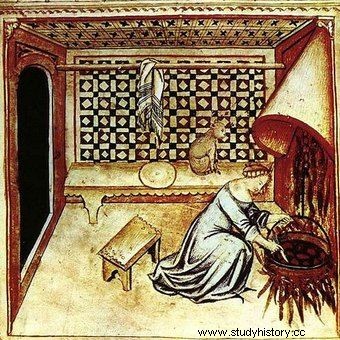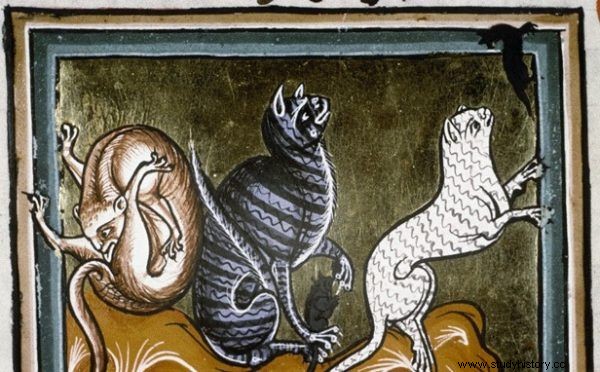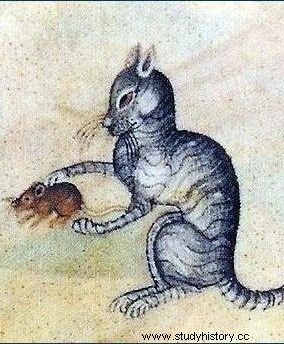The very thought that in the culture of the Far East it is normal to eat dog meat, makes many Europeans have hair on their heads. Meanwhile, our own ancestors often ate ... cats.
Officially, the cat - as a domestic creature - was considered one of the non-eaten animals already in the Middle Ages. Author of the 14th century Mannuel de conversation , a kind of guide to social and home life created in Bruges, placed cats on the list of forbidden foods, next to monkeys, foxes, donkeys, dogs, wolves and ... elephants. According to various sources, there were only two exceptions:cats were eaten by desperate, starving people, and by barbarians. 
The latter could hardly be accused of worse offenses than drinking human blood and… well, eating cats. In the 12th century, Bishop Otton of Freising quoted the accusations against Hungarians when they came to Europe:
During this period it was said that these people were so cruel and so wild that they ate raw meat and drank human blood. For those who find it unthinkable, I would like to remind you that the Pechenegs and the Polovtsians still eat raw meat (...) of horses and cats.
Cats also appear in an account of the siege of Ancona in 1173. The outraged chronicler noted:
Those who remained in the city suffered inexpressible hunger ... They killed horses, draft animals and donkeys and ate their unclean meat greedily, because hunger made all food bearable ... And some at that time, which no one has heard of since the beginning of the world and will not hear it until the end of the centuries, they ate dogs, cats and mice ...
In other words, there was no greater offense against prevailing customs than eating cats. We will draw the same conclusions from the descriptions of the siege of the Italian citadel at Rantra or the surroundings of the Hungarian troops by the Normandy Robert Guiscard.

Cats hunt mice, but who knows, maybe in a moment someone will hunt them and turn them into an exquisite dish?
Hildegard of Bingen sounded the alarm even louder, arguing that, as Laurence Bobis, author of The Cat. History and legends ”- eating cat flesh makes the body go crazy and it starts to smell.
Roof rabbit
Okay, so many theories and customs. It seems that, at least since the end of the Middle Ages, the reality was quite different , and cats in some regions of Europe have gained the status of ... a sophisticated treat .
Doctor Joachim Strupp in a dietary guide prepared in 1582 in the event of a famine (under the title: Last resort (...) or a new pantry and cellar - which was not mentioned before - in case of famine, poor harvest and war ) reminded that the Spaniards and Italians ate with fat cats and even encouraged their German colleagues to do likewise.
Konrad Gesner also noted around 1550 that cat meat was considered to be close to a rabbit's taste and was used in cooking in various parts of Europe, especially in Spain.
Of course, these two accounts have limited credibility, because the authors wrote in them about the customs of foreign, foreign cultures. But also the Italian, 16th-century naturalist Usilles Aldrovandi wrote in his book De quadrupedibus that cat meat is highly valued and eaten after baking or cooking:
Many do consider cat meat to be a very sophisticated dish although his brain is accused of being a poison ... Cat meat tastes very similar to rabbit.
The Spanish Archbishop of Toledo also assured that cat meat is juicy, easy to digest and puts people in a good mood. Even in France, which is said to have disliked cats, a 16th-century doctor admitted that there were plenty of people eating these animals with gusto.

Does cat meat taste similar to rabbit meat? This is what Konrad Gesner, who lived in the 16th century, said.
The popularity of cat consumption has been confirmed by studies in French dumps (since the 9th century, cat skeletons with characteristic traces of cuts have been found there), and the longevity of this custom ... 19th century folklore! Even in this epoch, which is very dear to us, Venetians were supposed to secretly eat cats, calling them ... "roof rabbits".
***

I wonder if this cat would make a good stew?
Finally, for amateurs of historical cuisine, a recipe for a cat stew, according to Ulysses Aldrovandi:
Pick a fat cat, cut its throat, then cut off its head and throw it away as it is not edible (…). Carefully remove the skin, cut it open and clean it thoroughly, then wrap it in a clean linen cloth and bury it in the ground, where it will stay for a day and one night, then take it out and start roasting on a spit (...) and when it starts to bake, lubricate it good garlic and oil, and after greasing, beat it with a stick, and when it is well baked, cut it open, as if it were a rabbit or a kid, put it on a large dish, take the garlic and oil that have separated, combine with a good, light broth and pour over the cat; now you can eat it because it is a very good dish.
If the topic interests you, we recommend Madeline Swan's book. "The History of Cats". There you will find even more interesting stories about cats .
Source:
Trivia is the essence of our website. Short materials devoted to interesting anecdotes, surprising details from the past, strange news from the old press. Reading that will take you no more than 3 minutes, based on single sources. This particular material is based on:
- Laurence Bobis, Cat. History and legends , Avalon 2008.
